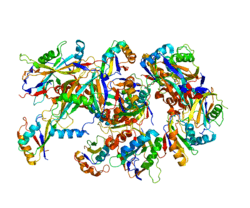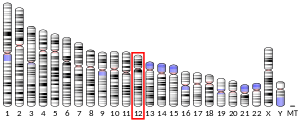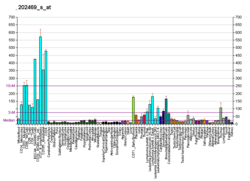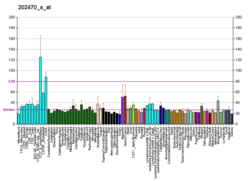CPSF6
Cleavage and polyadenylation specificity factor subunit 6 is a protein that in humans is encoded by the CPSF6 gene.[5][6][7]
Function
The protein encoded by this gene is one subunit of a cleavage factor required for 3' RNA cleavage and polyadenylation processing. The interaction of the protein with the RNA is one of the earliest steps in the assembly of the 3' end processing complex and facilitates the recruitment of other processing factors. The cleavage factor complex is composed of four polypeptides. This gene encodes the 68kD subunit. It has a domain organization reminiscent of spliceosomal proteins.[7]
Interactions
CPSF6 has been shown to interact with WWP1[8] and PLSCR1.[8]
gollark: Wasps who design lotteries and write C code extremely poorly due to bizarre beliefs about the nature of free will?
gollark: For example, I dislike memory unsafety, wasps, bad philosophy, lotteries, etc.
gollark: Technically, you specifically need annoying-to-us, which is easier.
gollark: Vespaforms?
gollark: <@293066066605768714> Have you done so yet?
References
- GRCh38: Ensembl release 89: ENSG00000111605 - Ensembl, May 2017
- GRCm38: Ensembl release 89: ENSMUSG00000055531 - Ensembl, May 2017
- "Human PubMed Reference:". National Center for Biotechnology Information, U.S. National Library of Medicine.
- "Mouse PubMed Reference:". National Center for Biotechnology Information, U.S. National Library of Medicine.
- Rüegsegger U, Blank D, Keller W (Jan 1998). "Human pre-mRNA cleavage factor Im is related to spliceosomal SR proteins and can be reconstituted in vitro from recombinant subunits". Molecular Cell. 1 (2): 243–53. doi:10.1016/S1097-2765(00)80025-8. PMID 9659921.
- Cardinale S, Cisterna B, Bonetti P, Aringhieri C, Biggiogera M, Barabino SM (Apr 2007). "Subnuclear localization and dynamics of the Pre-mRNA 3' end processing factor mammalian cleavage factor I 68-kDa subunit". Molecular Biology of the Cell. 18 (4): 1282–92. doi:10.1091/mbc.E06-09-0846. PMC 1838998. PMID 17267687.
- "Entrez Gene: CPSF6 cleavage and polyadenylation specific factor 6, 68kDa".
- Rual JF, Venkatesan K, Hao T, Hirozane-Kishikawa T, Dricot A, Li N, et al. (Oct 2005). "Towards a proteome-scale map of the human protein-protein interaction network". Nature. 437 (7062): 1173–8. doi:10.1038/nature04209. PMID 16189514.
External links
- Human CPSF6 genome location and CPSF6 gene details page in the UCSC Genome Browser.
Further reading
- Maruyama K, Sugano S (Jan 1994). "Oligo-capping: a simple method to replace the cap structure of eukaryotic mRNAs with oligoribonucleotides". Gene. 138 (1–2): 171–4. doi:10.1016/0378-1119(94)90802-8. PMID 8125298.
- Rüegsegger U, Beyer K, Keller W (Mar 1996). "Purification and characterization of human cleavage factor Im involved in the 3' end processing of messenger RNA precursors". The Journal of Biological Chemistry. 271 (11): 6107–13. doi:10.1074/jbc.271.11.6107. PMID 8626397.
- Suzuki Y, Yoshitomo-Nakagawa K, Maruyama K, Suyama A, Sugano S (Oct 1997). "Construction and characterization of a full length-enriched and a 5'-end-enriched cDNA library". Gene. 200 (1–2): 149–56. doi:10.1016/S0378-1119(97)00411-3. PMID 9373149.
- de Vries H, Rüegsegger U, Hübner W, Friedlein A, Langen H, Keller W (Nov 2000). "Human pre-mRNA cleavage factor II(m) contains homologs of yeast proteins and bridges two other cleavage factors". The EMBO Journal. 19 (21): 5895–904. doi:10.1093/emboj/19.21.5895. PMC 305781. PMID 11060040.
- Awasthi S, Alwine JC (Nov 2003). "Association of polyadenylation cleavage factor I with U1 snRNP". RNA. 9 (11): 1400–9. doi:10.1261/rna.5104603. PMC 1287061. PMID 14561889.
- Brown KM, Gilmartin GM (Dec 2003). "A mechanism for the regulation of pre-mRNA 3' processing by human cleavage factor Im". Molecular Cell. 12 (6): 1467–76. doi:10.1016/S1097-2765(03)00453-2. PMID 14690600.
- Dettwiler S, Aringhieri C, Cardinale S, Keller W, Barabino SM (Aug 2004). "Distinct sequence motifs within the 68-kDa subunit of cleavage factor Im mediate RNA binding, protein-protein interactions, and subcellular localization" (PDF). The Journal of Biological Chemistry. 279 (34): 35788–97. doi:10.1074/jbc.M403927200. PMID 15169763.
- Venkataraman K, Brown KM, Gilmartin GM (Jun 2005). "Analysis of a noncanonical poly(A) site reveals a tripartite mechanism for vertebrate poly(A) site recognition". Genes & Development. 19 (11): 1315–27. doi:10.1101/gad.1298605. PMC 1142555. PMID 15937220.
- Rual JF, Venkatesan K, Hao T, Hirozane-Kishikawa T, Dricot A, Li N, Berriz GF, Gibbons FD, Dreze M, Ayivi-Guedehoussou N, Klitgord N, Simon C, Boxem M, Milstein S, Rosenberg J, Goldberg DS, Zhang LV, Wong SL, Franklin G, Li S, Albala JS, Lim J, Fraughton C, Llamosas E, Cevik S, Bex C, Lamesch P, Sikorski RS, Vandenhaute J, Zoghbi HY, Smolyar A, Bosak S, Sequerra R, Doucette-Stamm L, Cusick ME, Hill DE, Roth FP, Vidal M (Oct 2005). "Towards a proteome-scale map of the human protein-protein interaction network". Nature. 437 (7062): 1173–8. doi:10.1038/nature04209. PMID 16189514.
- Millevoi S, Loulergue C, Dettwiler S, Karaa SZ, Keller W, Antoniou M, Vagner S (Oct 2006). "An interaction between U2AF 65 and CF I(m) links the splicing and 3' end processing machineries". The EMBO Journal. 25 (20): 4854–64. doi:10.1038/sj.emboj.7601331. PMC 1618107. PMID 17024186.
- Ewing RM, Chu P, Elisma F, Li H, Taylor P, Climie S, McBroom-Cerajewski L, Robinson MD, O'Connor L, Li M, Taylor R, Dharsee M, Ho Y, Heilbut A, Moore L, Zhang S, Ornatsky O, Bukhman YV, Ethier M, Sheng Y, Vasilescu J, Abu-Farha M, Lambert JP, Duewel HS, Stewart II, Kuehl B, Hogue K, Colwill K, Gladwish K, Muskat B, Kinach R, Adams SL, Moran MF, Morin GB, Topaloglou T, Figeys D (2007). "Large-scale mapping of human protein-protein interactions by mass spectrometry". Molecular Systems Biology. 3 (1): 89. doi:10.1038/msb4100134. PMC 1847948. PMID 17353931.
This article is issued from Wikipedia. The text is licensed under Creative Commons - Attribution - Sharealike. Additional terms may apply for the media files.






